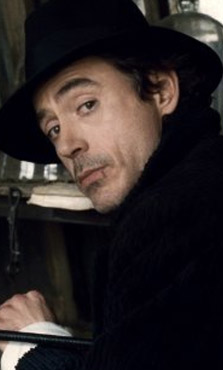
So much inane violence has been done to Arthur Conan Doyle’s legendary detective over the years that it would be deeply unfair to measure Guy Ritchie’s “re-boot” against the original with anything resembling scrupulous standards. Ritchie’s Holmes has a knockout ex (Rachel McAdams), kung fu skills, a Hollywood-handsome face (Downey, Jr.), and an even handsomer Watson (Jude Law). The mystery plot is implausible at best. There are more explosions than deductions. This is a postmodern reimagining of Holmes, and as such its real failing is that it doesn’t go nearly far enough; Baz Luhrmann would have done better than Ritchie, who never quite goes for it as he did in carnivalesque show-stoppers like “Snatch”. Ritchie tiptoes around the edges of Holmes’ darker tendencies, hinted at by Doyle and taken up by other interpreters, but why not jump in? The only mystery here is Ritchie’s fidelity to the source material, wobbly though it may be.
The pleasures of the film lie in the way Ritchie and his visual team conjure vague recollections and half-remembrances of earlier versions of Holmes and other late Victorian thrillers. The sooty, teetering, shadowy, rain-lashed London the digital artists have created quickly dominates the characters, much as it does in other films of its ilk (“The League of Extraordinary Gentlemen”, “Sweeney Todd”, “From Hell”, et cetera). Cinematic renderings of century-old texts permeate the digital mise en scene like an eerie fog: a shot of the Thames right out of Conrad, an over-vivid Chestertonian sunset, a murky Dickensian alleyway, a lamp-lit Stevensonian square. It’s as if three Hollywood stars awoke and found themselves in a dream fin de siècle London designed by video game 3D artists. In fact, the film feels exactly like a video game, with Holmes solving various small tasks resembling errand-puzzles rather than careful detection, fighting henchmen along the way to a climactic showdown with the main villain. For these reasons it is difficult to judge “Sherlock Holmes” as a film—like “Avatar” it doesn’t feel like a film at all but a well-made “virtual experience”.
Downey, Jr., Law, and McAdams make for a watchable threesome. Law is the best of the trio. He plays Watson’s longsuffering sidekick with the usual mixture of patience and exasperation all Watsons must have, while adding some rough-and-tumble violence to his palette. He and Downey, Jr. play off each other well, though Downey is so obviously not Sherlock Holmes that their chemistry is almost a moot point. The problem with Downey, Jr.’s Holmes is the daze in which he seems to hover at all times. His Holmes is an absent-minded professor plagued with a brain permanently distracted by its own fullness. Not too far removed from Doyle’s original, except that there’s no middle state in Downey, Jr.’s behavior. For example, in one of the fight scenes, he ambles vacantly around the ring, working through other problems in his head, until the last possible minute when, facing annihilation at the hands of a mountainous boxer, he immediately switches gears and delivers a flurry of punishing blows to the man even as his mind ties together threads in his investigation. Ritchie wants to dramatize the thought-process of a genius as a chess game made up only of knight-moves. It’s a weirdly obtuse gambit that ends up making intellection resemble a series of random epiphanies, as if Holmes were waiting for his subconscious to speak to him. “Thinking” for Ritchie’s Holmes means waiting for ideas to strike him like cartoon safes falling from high scaffolds.
The story concerns a nefarious plot by Lord Blackwood to enslave the world using a newly-invented modern technology. Lord Blackwood works for a mysterious evil mastermind whose true identity nobody should wonder about. The points of interest here are his association with a quasi-Masonic society—borrowed no doubt from Alan Moore’s “From Hell”—and the dual-layered terrorism plot. Blackwood attempts to first terrorize and then murder Parliament. To do so requires an apparent resurrection from the dead, a public spectacle fomenting an end-times dread among the citizens of London. In this way he is a conflation of present-day apocalyptic religious fundamentalists and classic headline-seeking terrorists preying on a frightened populace. This is one layer of the crime plot. The second is the development of the new technology, which is the ulterior motive of Blackwood’s patron, the puppet-master (and sequel-guaranteeing) Moriarty. Combined with the imagery of London as an industrial and imperial center of the world at the turn of a century, roiling with fear, as well as a paranoid suspicion of underground conspiracies, the dual-layered crime plot invokes and, at the same time, muddles our present-day anxieties about empire and the merging of terrorism and weapons of mass destruction.
Because the film is already a postmodern mish-mash of history and fiction (and the history of fiction), it’s fascinating to observe the way “Sherlock Holmes” re-imagines the dire problems of our time as a strange Freudian dreamscape, drawing as much on our fear of Osama Bin Laden as it does our concern that Robert Downey Jr. may have a drug relapse (the casting is no accident; Downey’s off-screen troubles resonate with Holmes’ addictive personality). Though off-putting in the way the film grinds serious matters into Hollywood chum, these spectral irruptions of the present reality, along with its idealized literary London, nevertheless give off an obscure allusive thrill. The movie’s incoherence is a virtue bordering on the supernatural. Ghosts of Holmes and Watson pop up here and there, along with transfigured scraps and echoes of history—Victorian, modern, Hollywood—as if restless spirits were speaking through the film. “Sherlock Holmes” is an entertaining cinematic séance, a surprise nobody would have relished more than Doyle. |